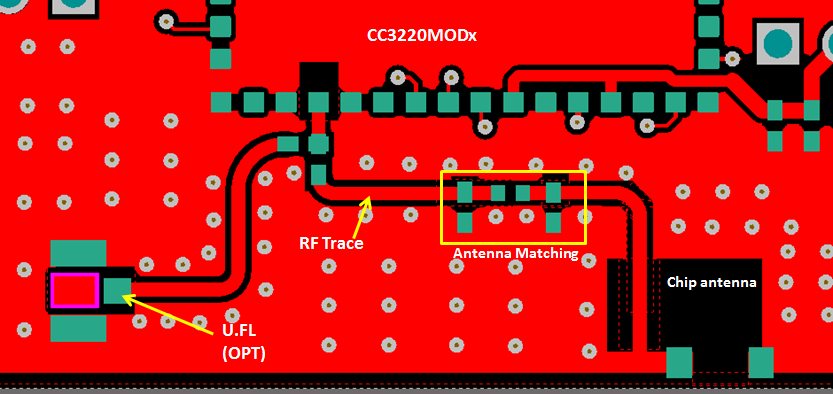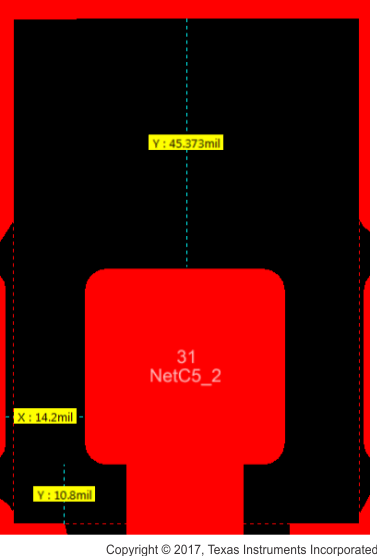ZHCSGZ7E March 2017 – May 2021 CC3220MOD , CC3220MODA
PRODUCTION DATA
- 1 特性
- 2 应用
- 3 说明
- 4 功能方框图
- 5 Revision History
- 6 Device Comparison
- 7 Terminal Configuration and Functions
-
8 Specifications
- 8.1 Absolute Maximum Ratings
- 8.2 ESD Ratings
- 8.3 Recommended Operating Conditions
- 8.4 Current Consumption (CC3220MODS and CC3220MODAS)
- 8.5 Current Consumption (CC3220MODSF and CC3220MODASF)
- 8.6 TX Power and IBAT Versus TX Power Level Settings
- 8.7 Brownout and Blackout Conditions
- 8.8 Electrical Characteristics
- 8.9 CC3220MODAx Antenna Characteristics
- 8.10 WLAN Receiver Characteristics
- 8.11 WLAN Transmitter Characteristics
- 8.12 Reset Requirement
- 8.13 Thermal Resistance Characteristics for MOB and MON Packages
- 8.14
Timing and Switching Characteristics
- 8.14.1 Power-Up Sequencing
- 8.14.2 Power-Down Sequencing
- 8.14.3 Device Reset
- 8.14.4 Wake Up From Hibernate Timing
- 8.14.5 Peripherals Timing
-
9 Detailed Description
- 9.1 Overview
- 9.2 Arm® Cortex®-M4 处理器内核子系统
- 9.3 Wi-Fi® Network Processor Subsystem
- 9.4 Security
- 9.5 Power-Management Subsystem
- 9.6 Low-Power Operating Mode
- 9.7 Memory
- 9.8 Restoring Factory Default Configuration
- 9.9 Boot Modes
- 9.10 Device Certification and Qualification
- 9.11 Module Markings
- 9.12 End Product Labeling
- 9.13 Manual Information to the End User
- 10Applications, Implementation, and Layout
- 11Environmental Requirements and Specifications
- 12Device and Documentation Support
- 13Mechanical, Packaging, and Orderable Information
请参考 PDF 数据表获取器件具体的封装图。
机械数据 (封装 | 引脚)
- MOB|63
散热焊盘机械数据 (封装 | 引脚)
10.3.2 CC3220MODx RF Layout Recommendations
The RF section of this wireless module gets top priority in terms of layout. It is very important for the RF section to be laid out correctly to ensure optimum performance from the module. A poor layout can cause low-output power, EVM degradation, sensitivity degradation, and mask violations.
Figure 10-2 shows the RF placement and routing of the CC3220MODx module with external antenna.
 Figure 10-2 RF Section Layout
Figure 10-2 RF Section LayoutFollow these RF layout recommendations for the CC320MODx device:
- RF traces must have 50-Ω impedance.
- RF trace bends must be made with gradual curves, and 90° bends must be avoided.
- RF traces must not have sharp corners.
- There must be no traces or ground under the antenna section.
- RF traces must have via stitching on the ground plane beside the RF trace on both sides.
- RF traces must be as short as possible. The antenna, RF traces, and the module must be on the edge of the PCB product in consideration of the product enclosure material and proximity.
For optimal RF performance, ensure the copper cut out on the top layer under the RF-BG pin (pin 31) is as shown in Figure 10-3.
 Figure 10-3 Top Layer Copper Pullback on RF Pads
Figure 10-3 Top Layer Copper Pullback on RF Pads